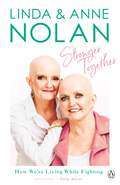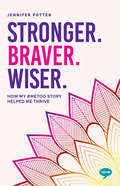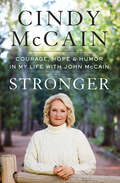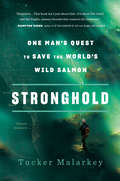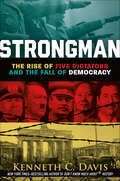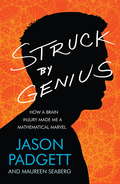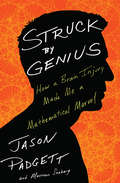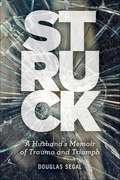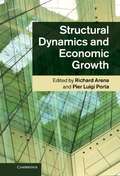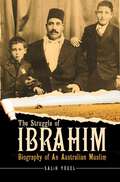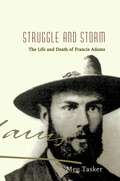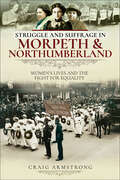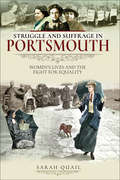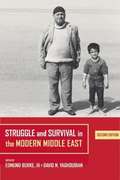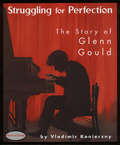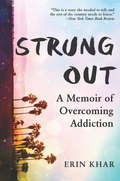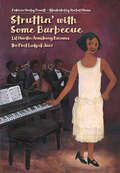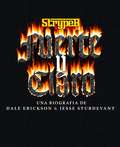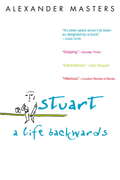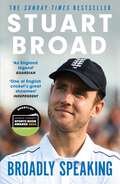- Table View
- List View
Stronger
by Gareth ThomasYou’re not born with resilience but you can find it on the journey with hard work, belief and the help of those around you.Gareth Thomas has learned to push on even when everything seems most futile. His willingness to expose his deepest emotional frailties as a man and come through even stronger as a result has made him a national hero. In the Sunday Times Bestseller PROUD, Gareth focused closely on the intense experience of coming out in a very public arena of global sport. STRONGER is the broader story of how Gareth has managed to deal with the adversity life has thrown at him across the years, from childhood to his most recent gruelling announcement that he was HIV positive.
Stronger Together: How We’re Living While Fighting
by Anne Nolan Linda Nolan"It's ok to be scared, to feel lonely... we'll get through it, because we have to."For more than 40 years Linda and Anne have performed side by side as members of iconic Irish girl group The Nolans. But in 2020 the sisters sat next to each other for a very different experience. Soon after returning home from filming their hit TV series The Nolans Go Cruising, with their sisters Coleen and Maureen, Linda and Anne received devastating cancer diagnoses within days of each other and soon began gruelling rounds of chemotherapy together. It was a stark reminder of how cruel life can be and, of course, of their beloved sister Bernie, who also faced and lost the same battle.Stronger Together is Linda and Anne's story. A reflection on their close-knit relationship, in the limelight and behind the scenes, and of how family helped them hold it all together when things got tough. Deeply personal, incredibly moving and told with trademark humour, it's a story they hope will help you too.
Stronger than Death: Hart Crane's Last Year in Mexico
by Francesca Bratton'Poignant and fiercely intelligent, this is the best work of creative non-fiction I have read in years' FIONA MOZLEYIn April 1931, modernist poet Hart Crane arrived in Mexico City. Between mood swings, dire financial difficulties, and a rotating series of personal estrangements, Hart was struggling to make the parts of a fragmentary world cohere. This move to Mexico was one in a long list of attempts to find security. In just over a year he would be dead.In July 1932, Grace Crane picks up the morning paper. Scanning the headlines, she is halted on page five. Her son's eyes stare back at her, tinted pink by the thin paper: 'POET LOST AT SEA FROM SHIP'.Hart Crane's last year has accrued a morbid mythology, seen as a period of self-destructive creative drought. In Stronger than Death Francesca Bratton tracks Hart's year among the vibrant artistic and political communities of Mexico City. His story is interwoven with that of his mother, exploring Grace's lifelong frustrated creativity and, after his death, debilitating grief. Finally the book explores Hart's legacy as a queer man and as a poet, informed by Francesca's responses to his work during her own periods of struggling with mental illness.Part-memoir, part-biography, Stronger than Death is a profound and lyrical meditation on grief, mental health, enduring love and the power of poetry.
Stronger. Braver. Wiser.: How My #MeToo Story Helped Me Thrive (Inspirational Series)
by Jennifer PotterJennifer Potter might never have said anything. She might have just let everything rest. But after seeing the progress made by the #MeToo movement, she knew she had to speak up. So she told the police about her rape.At just 17 years old, she was assaulted by a family friend, someone close to her. She told her parents but she didn’t report it. Filled with shame about what had happened, she tried to forget about it instead. But trauma leaves scars that can’t be seen, and she spent years trying to run away, only to find that she kept running into the very thing she was trying to flee.And so she chose to file a report, in the hope that she might heal. But revisiting the trauma brought everything back: the memories, the pain, the shame of being assaulted. And being questioned on the stand, 20 years after the attack, was like a living nightmare. Maybe this was all for nothing …Stronger Braver Wiser is fundamentally a story of triumph; a real-life David vs Goliath tale of a woman finding her own justice in a world that sought to rob her of it.
Stronger: Courage, Hope, and Humor in My Life with John McCain
by Cindy McCainThe widow of Senator John McCain opens up about her beloved husband, their thirty-eight-year marriage, and the trials and triumphs of a singular American life. My husband, John McCain, never viewed himself as larger than life—but he was. He had more tenacity and resolve than anybody I ever met. Being with him didn&’t hold me back—it gave me flight, a courage I never would have felt on my own. Cindy Hensley was just out of college when she met and fell in love with the celebrated Navy hero John McCain. They embarked on a thrilling life together that put her at the center of American politics for over four decades. In this moving and inspiring memoir, Cindy McCain tells the story of her adventurous life with John for the first time. Raising their four children in Arizona while John flourished as a six-term senator in Washington, D.C., Cindy brought her own flair to the role of political wife. She eagerly supported John&’s career even as she tried hard to stay out of the spotlight and maintain her own health and well-being. She is honest in revealing her own successes and missteps, discussing how she dealt with political attacks targeting her children, her battle with opioid addiction, and the wild whirl of campaigning for president. As they built their life together, Cindy and John continued the multi-generation McCain tradition of service to country. With both immense pride and deep worry, she sent two sons off to active duty in the military. She describes her own brave efforts bringing medical support to countries in crisis and empowering women in Africa and around the world. And she reveals her feelings about the tumultuous effects of the Trump presidency on the military. Most important, this book shares how John&’s humor and strength helped Cindy grow into the confident woman she is now. More than a political story, Stronger is the unforgettable journey of one woman who believes in family, honor, and country—and is willing to stand up for all of them.
Stronghold: One Man's Quest to Save the World's Wild Salmon
by Tucker Malarkey“A powerful and inspiring story. Guido Rahr’s mission to save the wild Pacific salmon leads him into adventures that make for a breathtakingly exciting read.”—Ian Frazier, author of Travels in Siberia In the tradition of Mountains Beyond Mountains and The Orchid Thief, Stronghold is Tucker Malarkey’s eye-opening account of an unlikely visionary and his crusade to protect the world’s last bastion of wild salmon. From a young age, Guido Rahr was a misfit among his family and classmates, preferring to spend his time in the natural world. An obsessive fly fisherman, Rahr noticed when the salmon runs of the Pacific Northwest began to decline—and was one of the few who understood why. As dams, industry, and climate change degraded the homes of these magnificent fish, Rahr saw that the salmon of the Pacific Rim were destined to go the way of their Atlantic brethren: near extinction. An improbable and inspiring story, Stronghold takes us on a wild adventure, from Oregon to Alaska to one of the world’s last remaining salmon strongholds in the Russian Far East, a landscape of ecological richness and diversity that is rapidly being developed for oil, gas, minerals, and timber. Along the way, Rahr contends with scientists, conservationists, Russian oligarchs, corrupt officials, and unexpected allies in an attempt to secure a stronghold for the endangered salmon, an extraordinary keystone species whose demise would reverberate across the planet.Tucker Malarkey, who joins Rahr in the Russian wilderness, has written a clarion call for a sustainable future, a remarkable work of natural history, and a riveting account of a species whose future is closely linked to our own.Advance praise for Stronghold“This book isn’t just about fish, it’s about life itself and the fragile unseen threads that connect all creatures across this beleaguered orb we call home. Guido Rahr’s quest to save the world’s wild salmon should serve as an inspiration—and a provocation—for us all, and Tucker Malarkey’s exquisite book captures Rahr’s weird and wonderful story with poignancy, humor, and grace.”—Hampton Sides, author of In the Kingdom of Ice and Blood and Thunder“A crazy-good, intensely lived book that reads like an international thriller—only it’s our beloved salmon playing the part of diamonds or oil or gold.”—David James Duncan, author of The River Why and The Brothers K
Strongman: The Rise of Five Dictators and the Fall of Democracy
by Kenneth C. DavisFrom the bestselling author of the Don’t Know Much About® books comes a dramatic account of the origins of democracy, the history of authoritarianism, and the reigns of five of history's deadliest dictators. A Washington Post Best Book of the Year!A Bank Street College of Education Best Book of the Year! A YALSA 2021 Nonfiction Award Nominee!What makes a country fall to a dictator? How do authoritarian leaders—strongmen—capable of killing millions acquire their power? How are they able to defeat the ideal of democracy? And what can we do to make sure it doesn’t happen again?By profiling five of the most notoriously ruthless dictators in history—Adolf Hitler, Benito Mussolini, Joseph Stalin, Mao Zedong, and Saddam Hussein—Kenneth C. Davis seeks to answer these questions, examining the forces in these strongmen’s personal lives and historical periods that shaped the leaders they’d become. Meticulously researched and complete with photographs, Strongman provides insight into the lives of five leaders who callously transformed the world and serves as an invaluable resource in an era when democracy itself seems in peril.* "A fascinating, highly readable portrayal of infamous men that provides urgent lessons for democracy now." —Publishers Weekly, starred review "Strongman is a book that is both deeply researched and deeply felt, both an alarming warning and a galvanizing call to action, both daunting and necessary to read and discuss." —Cynthia Levinson, author of Fault Lines in the Constitution
Struck by Genius: How a Brain Injury Made Me a Mathematical Marvel
by Jason Padgett Maureen SeabergJason Padgett was an ordinary, not terribly bright, 41-year-old working in his father's furniture shop when he was the victim of a brutal mugging outside a karaoke bar in 2002.That same night his stepfather died of cancer, and two weeks later his only brother went missing (his body was discovered three year later). The combined traumas of these three events proved, unsurprisingly, too much for Jason and he withdrew from life completely, living as a hermit for four years suffering with agoraphobia and the onset of OCD. During this time he developed a fascination with the principles of the physical universe, devouring mathematics and physics journals. He also started to see intricate webs of shapes in his head and discovered that he could draw these by hand.A chance encounter in a mall pointed him in the direction of college. There, his extraordinary mind was recognised, and he was set on a path in which his drawings were identified as mathematical fractals and neuroscientists were able to diagnose a unique individual.Jason is a miraculous everyman with an inspiring 'what if' story that pushes beyond the boundaries of what scientists thought possible.
Struck by Genius: How a Brain Injury Made Me a Mathematical Marvel
by Jason Padgett Maureen SeabergFrom head trauma to scientific wonder—a &“deeply absorbing . . . fascinating&” true story of acquired savant syndrome (Entertainment Weekly). Twelve years ago, Jason Padgett had never made it past pre-algebra. But a violent mugging forever altered the way his brain worked. It turned an ordinary math-averse student into an extraordinary young man with a unique gift to see the world as no one else does: water pours from the faucet in crystalline patterns, numbers call to mind distinct geometric shapes, and intricate fractal patterns emerge from the movement of tree branches, revealing the intrinsic mathematical designs hidden in the objects around us. As his ability to understand physics skyrocketed, the &“accidental genius&” developed the astonishing ability to draw the complex geometric shapes he saw everywhere. Overcoming huge setbacks and embracing his new mind, Padgett &“gained a vision of the world that is as beautiful as it is challenging.&” Along the way he fell in love, found joy in numbers, and spent plenty of time having his head examined (The New York Times Book Review). Illustrated with Jason&’s stunning, mathematically precise artwork, his singular story reveals the wondrous potential of the human brain, and &“an incredible phenomenon which points toward dormant potential—a little Rain Man perhaps—within us all&” (Darold A. Treffert, MD, author of Islands of Genius: The Bountiful Mind of the Autistic, Acquired, and Sudden Savant). &“A tale worthy of Ripley&’s Believe It or Not! . . . This memoir sends a hopeful message to families touched by brain injury, autism, or neurological damage from strokes.&” —Booklist &“How extraordinary it is to contemplate the bizarre gifts that might lie within all of us.&” —People
Struck: A Husband's Memoir Of Trauma And Triumph
by Douglas SegalOne of life's biggest clichés becomes a horrific reality when Douglas Segal's wife and young daughter are hit head-on by a Los Angeles city bus. Miraculously, his daughter was unharmed, but his wife faced a series of life-threatening injuries, including the same one that famously left Christopher Reeve paralyzed. Following the accident, Segal began sending regular email updates to their circle of friends and family--a list that continued to grow as others heard of the event and were moved by the many emotional and spiritual issues it raised. Segal's compelling memoir is an intimate and honest chronicle built around these email updates, and is a profound example of how people show up for one another in times of crisis. Alternatingly harrowing, humorous, heartbreaking, and hopeful, this is an uplifting tribute to love, determination, and how the compassion of community holds the power to heal, serving as an inspiring testament to the resilience of the human spirit when faced with pain and adversity.
Struck: One Christian's Reflections on Encountering Death
by Russ RamseyEPA 2018 Christian Book Award Finalist - Biography and Memoir"When my doctor told me I was dying, I came alive."
Structural Dynamics and Economic Growth
by Richard Arena Pier Luigi PortaEver since Adam Smith, economists have been preoccupied with the puzzle of economic growth. The standard mainstream models of economic growth were and often still are based either on assumptions of diminishing returns on capital with technological innovation or on endogenous dynamics combined with a corresponding technological and institutional setting. An alternative model of economic growth emerged from the Cambridge School of Keynesian economists in the 1950s and 1960s. This model - developed mainly by Luigi Pasinetti - emphasizes the importance of demand, human learning and the growth dynamics of industrial systems. Finally, in the past decade, new mainstream models have emerged incorporating technology or demand-based structural change and extending the notion of balanced growth. This collection of essays reassesses Pasinetti's theory of structural dynamics in the context of these recent developments, with contributions from economists writing in both the mainstream and the Cambridge Keynesian traditions and including Luigi Pasinetti, William Baumol, Geoffrey Harcourt and Nobel laureate Robert Solow.
Struggle Of Ibrahim
by Salih YucelIbrahim Dellal is a leading Muslim figure and key person in Muslim history in post- WWII Australia. Born in Cyprus in 1932, Ibrahim established or helped establish many religious, educational, and cultural organizations, holding major roles in each since he moved to Australia in 1950. This book is a biographical work on the fascinating life of a person who devoted himself to community service and interfaith dialogue.
Struggle and Storm: The Life and Death of Francis Adams
by Meg TaskerFrancis William Lauderdale Adams (1862-1893)—poet, novelist, social analyst and journalist—made a significant place for himself in Australian literary and cultural history. Born in England, he was a self-consciously modern writer of the fin de siècle; the theme of suicide figured frequently in his writings, and in death he embodied the romantic myth of the consumptive artist. Adams arrived in Australia in 1884, full of democratic and literary aspirations, and set out to explore the cultural landscape of his adopted country. A charismatic figure, he was loved by many for his personal beauty and eloquence and for the insouciant charm which smoothed over the sharp edges of his political radicalism and intellectual arrogance. But his impact on Australian cultural history was larger than the merely personal. He influenced a whole generation of idealistic young socialists in Australia, and had a leading role in the development of the Australian labour movement. Much of his best work was concerned with Australian social and political developments in the years leading up to Federation, and his book The Australians (1893) is a much-quoted classic of Australian social commentary. He was an early and influential spokesman for the Australian nationalism of the 1890s, articulating ideas of democracy and independence from England. In Struggle and Storm, Meg Tasker explores with texture and nuance both the pleasures of biography and the interesting problem of how to write a literary life a hundred years later. This engaging work is the first full-length biographical study of Francis Adams.
Struggle and Suffrage in Morpeth & Northumberland: Women's Lives and the Fight for Equality (Struggle And Suffrage Ser.)
by Craig ArmstrongA portrait of the battle for voting rights in a rural English county, and the dramatic life and death of one fierce suffragette.For much of the nineteenth century, the women of Northumberland occupied crucial, though largely underappreciated, roles in society. Aside from the hard life of raising families in an area where money was often hard to come by and much of the available work was labor-intensive and dangerous, women were also expected to help bring money into the household.In what was a largely agrarian county, female laborers, known as bondagers, were widely respected for their contribution to the local economy, though there were those who criticized the system for forcing women to undertake hard manual labor. The farming economy in Northumberland depended so much on female labor that many men found it easier to be taken on by an employer if they were able to bring a suitable female worker with them.The period was also one of considerable upheaval. There were a number of prominent Northumbrian suffragists, and the local radical suffragettes launched attacks in the area. Morpeth was a very early supporter of women’s suffrage and the mayor and local council actively supported the cause, though they remained largely opposed to the actions of the suffragettes. Among other topics, this book follows the story of London-born Emily Wilding Davison, whose mother was Northumbrian and had a wide network of relations in the county. After her father’s death, her mother relocated to the Northumberland village of Longhorsley and Emily spent long periods with her, recuperating after her numerous hunger strikes. Famously losing her life after being struck by the king’s horse at the 1913 Epsom Derby, Emily was buried with great ceremony in a quiet churchyard and to this day remains one of Morpeth’s most famous (adopted) daughters, her grave a site of pilgrimage for supporters of women’s rights.
Struggle and Suffrage in Portsmouth: Women's Lives and the Fight for Equality (Struggle And Suffrage Ser.)
by Sarah QuailThe women of Portsmouth had of necessity to be tough. They kept their families together during long naval and military deployments overseas, raising their children on their own for much of this time. They worked in domestic service, in nearby stay factories or simply took in sewing to complete in their own homes, often with the help of their children.The local suffrage campaign was driven as much by the lack of opportunities for middle-class women as reaction to sweating in local stay factories and the injustices of the Contagious Diseases Acts. Womens own voices are seldom heard in surviving sources before the end of the 19th century, but as the century came to an end suffragists, pioneers of womens education, women who stood for public office for the first time, and those who entered the professions began to step forward.The First World War gave women the opportunity to prove that they could be effectively integrated into a male workforce. Similar sentiments were expressed by local women barely a generation later during the Second World War. This time the war came to Portsmouth and much of the old city was destroyed by enemy bombing. With their men away, women had to cope on their own with this wholesale destruction of their homes and communities - and the deaths of relations and friends.Womens own voices are heard most effectively for the first time in the postwar period through the medium of oral history. Recordings made over the last thirty years and printed, edited extracts of those recordings are used to detail womens lives and more recent times, and the continuing fight for equality.
Struggle and Survival in the Modern Middle East (2nd edition)
by Edmund Burke David N. YaghoubianA collection of short biographies of ordinary men and women whose lives tell the story of today's Middle East. This second edition has been revised to include six new contemporary stories to bring the book up to date.
Struggling for Perfection: The Story of Glenn Gould
by Vladimir KoniecznyStruggling for Perfection is the story of the famous pianist, an enigmatic figure who made some of the most acclaimed classical recordings of the last century. A former child prodigy and an unpredictable, passionate man, Glenn Gould was known as much for his eccentricities as his vast musical genius. After retiring prematurely from performing, Gould branched out into work in film and radio and helped bring classical music recording technology into a new age. He has became a national icon in Canada. Vladimir Konieczny delivers a sensitive and affectionate portrait of this imposing figure in music history. The book is illustrated with sketches and archival photos.
Strung Out: One Last Hit and Other Lies That Nearly Killed Me
by Erin Khar“This vital memoir will change how we look at the opioid crisis and how the media talks about it. A deeply moving and emotional read, STRUNG OUT challenges our preconceived ideas of what addiction looks like.”—Stephanie Land, New York Times bestselling author of MaidIn this deeply personal and illuminating memoir about her fifteen-year struggle with heroin, Khar sheds profound light on the opioid crisis and gives a voice to the over two million people in America currently battling with this addiction.Growing up in LA, Erin Khar hid behind a picture-perfect childhood filled with excellent grades, a popular group of friends and horseback riding. After first experimenting with her grandmother’s expired painkillers, Khar started using heroin when she was thirteen. The drug allowed her to escape from pressures to be perfect and suppress all the heavy feelings she couldn’t understand.This fiercely honest memoir explores how heroin shaped every aspect of her life for the next fifteen years and details the various lies she told herself, and others, about her drug use. With enormous heart and wisdom, she shows how the shame and stigma surrounding addiction, which fuels denial and deceit, is so often what keeps addicts from getting help. There is no one path to recovery, and for Khar, it was in motherhood that she found the inner strength and self-forgiveness to quit heroin and fight for her life.Strung Out is a life-affirming story of resilience while also a gripping investigation into the psychology of addiction and why people turn to opioids in the first place.
Struttin' with Some Barbecue: Lil Hardin Armstrong Becomes the First Lady of Jazz
by Patricia Hruby PowellLil Hardin and her man, Louis Armstrong, were musical royalty--inventing a new kind of sound--makin' jazz. Believe it, baby!This is the true story of Lil Hardin Armstrong: pianist, composer, and bandleader in the early days of jazz. Ahead of her time, Lil made a career for herself--and for Louis Armstrong, her modest, unassuming husband. Louis might never have become the groundbreaking jazz player he was, if it hadn't been for Lil. Scat-inspired verse celebrates how Lil overcame race and gender barriers to become the first lady of the Chicago jazz scene."Brimming with a contagious love of jazz and its first lady, this work brings down the house"--Kirkus Reviews, STARRED review
Stryper: Fuerte y Claro
by Dale Erickson Jesse SturdevantEste libro relata toda la historia de esta legendaria banda de metal cristiano. Desde la infancia de los miembros, la época del Roxx Regime, su éxito en la radio y MTV, y los estadios llenos, hasta las triunfantes giras de reunión y las grabaciones, cubre casi todo lo que hay que saber sobre Stryper, y no sólo la palabrería. Preguntas como "¿Cómo evolucionó Stryper?" o "¿Qué ocurrió realmente durante el periodo de Against the Law?" tienen respuesta aquí. Las respuestas, derivadas de incontables horas de entrevistas, proceden directamente de los propios miembros de la banda y de muchas otras fuentes.
Stuart A Life Backwards: A Life Backwards (Perennial Non-fiction Promotion Ser.)
by Alexander MastersA major new launch for the paperback edition of the most original, capitvating and award-winning memoir of the year. Stuart, A Life Backwards, is the story of a remarkable friendship between a reclusive writer and illustrator ('a middle class scum ponce, if you want to be honest about it, Alexander) and a chaotic, knife-wielding beggar whom he gets to know during a campaign to release two charity workers from prison. Interwoven into this is Stuart's confession: the story of his life, told backwards. With humour, compassion (and exasperation) Masters slowly works back through post-office heists, prison riots and the exact day Stuart discovered violence, to unfold the reasons why he changed from a happy-go-lucky little boy into a polydrug-addicted-alcoholic Jekyll and Hyde personality, with a fondness for what he called 'little strips of silver' (knives to you and me). Funny, despairing, brilliantly written and full of surprises: this is the most original and moving biography of recent years.
Stuart Adamson: In a Big Country
by Glen AllanA music journalist and fan examines the life and work of the Scottish guitarist, vocalist, and songwriter. The book that fans of the Skids, Big Country and the Raphaels have been waiting for—a critical perspective not only of Adamson&’s music and its wider cultural influence, but also the excesses of fame and how the music business really works. Stuart Adamson: In A Big Country tells the story of how a teenager who was raised in a small Fife village released his first single at 19, wrote three Top 40 albums in the next three years and was written off as a has-been at 23, but then went on to form a new band and sell more than 10 million records worldwide, touring with the Rolling Stones and David Bowie. Although Adamson was one of the most respected and popular figures in the music industry, his personal life was complex and ultimately tragic, ending with his alcohol-fueled suicide in a Hawaiian hotel in December, 2001.&“He was a massive, massive influence on me . . . Absolute genius.&” —James Dean Bradfield, Manic Street Preachers&“An overdue tribute to a visionary musician and honorable man.&” —Keith Cameron, Mojo&“Engaging journey through the peaks and troughs of an ultimately troubled life . . . Moving and well-judged.&” —Rob Hughes, The Word
Stuart Broad: PRE-ORDER HIS MUST-READ AUTOBIOGRAPHY NOW
by Stuart BroadPre-order the must-read sports autobiography of 2023THE SWING. THE SEAM. THE STORY. __________ Stuart Broad is the ultimate competitor - someone addicted to the pressures of Test cricket, the big occasions and being thrust into the heat of battle. For over seventeen years, he's left it all on the field. A multiple Ashes winner and World Champion, Broad was integral to some of the greatest England teams of all time. His awards and achievements, however, don't tell the whole story. He has always been a cricketer of more than mere numbers. Broad's passionate and spontaneous behaviour has made him a fan favourite. No other player feeds off the crowd quite like he does. In his autobiography, Broad shares the moments from the game which have made him and those that almost broke him. What's clear, however, is his unwavering belief in his own ability to become one of the best ever. Candid, entertaining, and refreshingly honest, this book reveals the personal side of a true cricketing great. __________ 'The longevity of his career, and what he has achieved, should never be forgotten' Ben Stokes 'He loves the big moments, the pressure situations. That's a true sign of a champion, I think. He's been incredible for England for a long, long time' Glen McGrath 'Stuart Broad is the ultimate Ashes warrior' Ricky Ponting 'One of England's greatest players of all time' Joe Root
Stuart Broad: THE MUST-READ SPORTS AUTOBIOGRAPHY OF 2023
by Stuart BroadOut now: the must-read sports autobiography of 2023THE SWING. THE SEAM. THE STORY. __________ Stuart Broad is the ultimate competitor - someone addicted to the pressures of Test cricket, the big occasions and being thrust into the heat of battle. For over seventeen years, he's left it all on the field. A multiple Ashes winner and World Champion, Broad was integral to some of the greatest England teams of all time. His awards and achievements, however, don't tell the whole story. He has always been a cricketer of more than mere numbers. Broad's passionate and spontaneous behaviour has made him a fan favourite. No other player feeds off the crowd quite like he does. In his autobiography, Broad shares the moments from the game which have made him and those that almost broke him. What's clear, however, is his unwavering belief in his own ability to become one of the best ever. Candid, entertaining, and refreshingly honest, this book reveals the personal side of a true cricketing great. __________ 'The longevity of his career, and what he has achieved, should never be forgotten' Ben Stokes 'He loves the big moments, the pressure situations. That's a true sign of a champion, I think. He's been incredible for England for a long, long time' Glen McGrath 'Stuart Broad is the ultimate Ashes warrior' Ricky Ponting 'One of England's greatest players of all time' Joe Root

